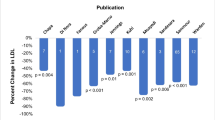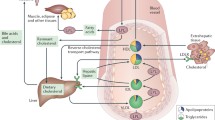Abstract
Sirolimus used in transplantation is often associated with hypercholesterolemia. We measured serum lipid and PCSK9 levels in 51 heart transplant recipients who had their immunosuppressive therapy switched from calcineurin inhibitors to sirolimus. The switch resulted in a 23% increase in LDL cholesterol, and 46% increase in triglycerides and PCSK9 levels increased from 316 ± 105 ng/mL to 343 ± 107 ng/mL (p = 0.04), however the change in PCSK9 levels did not correlate with an increase in lipid levels (p = 0.2). To investigate the mechanism for the variability in the change in PCSK9 levels, lymphoblastoid cell lines were incubated with both sirolimus and everolimus, resulting in a 2–3 fold increase in PCSK9 expression and protein levels in mTOR inhibitor sensitive but not in mTOR inhibitor resistant cell lines. This first in human study demonstrates that sirolimus therapy is associated with elevation in PCSK9 levels which is not associated with sirolimus-induced hypercholesterolemia.




Similar content being viewed by others
Abbreviations
- (AA):
-
African–American
- (CNI):
-
calcineurin inhibitor
- (CA):
-
Caucasian–American
- (HCA):
-
Han Chinese–American
- (LCL):
-
Lymphoblastoid Cell Lines
- (PCSK9):
-
Proprotein convertase subtilisin/kexin Type 9
- (SREBP):
-
sterol regulatory element-binding protein
References
Neuhaus, P., Klupp, J., & Langrehr, J. M. (2001). mTOR inhibitors: an overview. Liver Transplantation, 7(6), 473–484. doi:10.1053/jlts.2001.24645.
Harrison, D. E., Strong, R., Sharp, Z. D., Nelson, J. F., Astle, C. M., Flurkey, K., et al. (2009). Rapamycin fed late in life extends lifespan in genetically heterogeneous mice. Nature, 460(7253), 392–395. doi:10.1038/nature08221.
Bak, T., Wachs, M., Trotter, J., Everson, G., Trouillot, T., Kugelmas, M., et al. (2001). Adult-to-adult living donor liver transplantation using right-lobe grafts: results and lessons learned from a single-center experience. Liver Transplantation, 7(8), 680–686. doi:10.1053/jlts.2001.26509.
Brattstrom, C., Wilczek, H., Tyden, G., Bottiger, Y., Sawe, J., & Groth, C. G. (1998). Hyperlipidemia in renal transplant recipients treated with sirolimus (rapamycin). Transplantation, 65(9), 1272–1274.
MacDonald, A. S. (2001). A worldwide, phase III, randomized, controlled, safety and efficacy study of a sirolimus/cyclosporine regimen for prevention of acute rejection in recipients of primary mismatched renal allografts. Transplantation, 71(2), 271–280.
Neff, G. W., Montalbano, M., Slapak-Green, G., Berney, T., Bejarano, P. A., Joshi, A., et al. (2003). A retrospective review of sirolimus (Rapamune) therapy in orthotopic liver transplant recipients diagnosed with chronic rejection. Liver Transplantation, 9(5), 477–483. doi:10.1053/jlts.2003.50119.
Raichlin, E., Bae, J. H., Khalpey, Z., Edwards, B. S., Kremers, W. K., Clavell, A. L., et al. (2007). Conversion to sirolimus as primary immunosuppression attenuates the progression of allograft vasculopathy after cardiac transplantation. Circulation, 116(23), 2726–2733. doi:10.1161/CIRCULATIONAHA.107.692996.
Beutner, F., Brendel, D., Teupser, D., Sass, K., Baber, R., Mueller, M., et al. (2012). Effect of everolimus on pre-existing atherosclerosis in LDL-receptor deficient mice. Atherosclerosis, 222(2), 337–343. doi:10.1016/j.atherosclerosis.2012.03.003.
Zhang, D. W., Lagace, T. A., Garuti, R., Zhao, Z., McDonald, M., Horton, J. D., et al. (2007). Binding of proprotein convertase subtilisin/kexin type 9 to epidermal growth factor-like repeat a of low density lipoprotein receptor decreases receptor recycling and increases degradation. The Journal of Biological Chemistry, 282(25), 18602–18612. doi:10.1074/jbc.M702027200.
Lamming, D. W., & Sabatini, D. M. (2013). A central role for mTOR in lipid homeostasis. Cell Metabolism, 18(4), 465–469. doi:10.1016/j.cmet.2013.08.002.
Ai, D., Chen, C., Han, S., Ganda, A., Murphy, A. J., Haeusler, R., et al. (2012). Regulation of hepatic LDL receptors by mTORC1 and PCSK9 in mice. Journal of Clinical Investigation, 122(4), 1262–1270. doi:10.1172/jci61919.
Jiang, J., Fridley, B. L., Feng, Q., Abo, R. P., Brisbin, A., Batzler, A., et al. (2013). Genome-wide association study for biomarker identification of rapamycin and everolimus using a lymphoblastoid cell line system. Frontiers in Genetics, 4, 166. doi:10.3389/fgene.2013.00166.
Leander, K., Malarstig, A., Van't Hooft, F. M., Hyde, C., Hellenius, M. L., Troutt, J. S., et al. (2016). Circulating proprotein convertase subtilisin/kexin type 9 (PCSK9) predicts future risk of cardiovascular events independently of established risk factors. Circulation, 133(13), 1230–1239. doi:10.1161/circulationaha.115.018531.
Ehninger, D., Neff, F., & Xie, K. (2014). Longevity, aging and rapamycin. Cellular and Molecular Life Sciences, 71(22), 4325–4346. doi:10.1007/s00018-014-1677-1.
Schulz, R., Schluter, K. D., & Laufs, U. (2015). Molecular and cellular function of the proprotein convertase subtilisin/kexin type 9 (PCSK9). Basic Research in Cardiology, 110(2), 4. doi:10.1007/s00395-015-0463-z.
Tavori, H., Rashid, S., & Fazio, S. (2015). On the function and homeostasis of PCSK9: reciprocal interaction with LDLR and additional lipid effects. Atherosclerosis, 238(2), 264–270. doi:10.1016/j.atherosclerosis.2014.12.017.
Neff, G. W., Montalbano, M., Slapak-Green, G., Meyer, D., Berney, T., Safdar, K., et al. (2003). Sirolimus therapy in orthotopic liver transplant recipients with calcineurin inhibitor related chronic renal insufficiency. Transplantation Proceedings, 35(8), 3029–3031.
Trotter, J. F., Wachs, M. E., Trouillot, T. E., Bak, T., Kugelmas, M., Kam, I., et al. (2001). Dyslipidemia during sirolimus therapy in liver transplant recipients occurs with concomitant cyclosporine but not tacrolimus. Liver Transplantation, 7(5), 401–408. doi:10.1053/jlts.2001.23916.
Arsenault, B. J., Pelletier-Beaumont, E., Almeras, N., Tremblay, A., Poirier, P., Bergeron, J., et al. (2014). PCSK9 levels in abdominally obese men: association with cardiometabolic risk profile and effects of a one-year lifestyle modification program. Atherosclerosis, 236(2), 321–326. doi:10.1016/j.atherosclerosis.2014.07.010.
Lakoski, S. G., Lagace, T. A., Cohen, J. C., Horton, J. D., & Hobbs, H. H. (2009). Genetic and metabolic determinants of plasma PCSK9 levels. Journal of Clininical Endocrinology & Metabolism, 94(7), 2537–2543. doi:10.1210/jc.2009-0141.
Haas, M. E., Levenson, A. E., Sun, X., Liao, W. H., Rutkowski, J. M., de Ferranti, S. D., et al. (2016). The role of proprotein convertase subtilisin/kexin type 9 in nephrotic syndrome-associated hypercholesterolemia. Circulation, 134(1), 61–72. doi:10.1161/circulationaha.115.020912.
Morrisett, J. D., Abdel-Fattah, G., Hoogeveen, R., Mitchell, E., Ballantyne, C. M., Pownall, H. J., et al. (2002). Effects of sirolimus on plasma lipids, lipoprotein levels, and fatty acid metabolism in renal transplant patients. Journal of Lipid Research, 43(8), 1170–1180.
Tur, M. D., Garrigue, V., Vela, C., Dupuy, A. M., Descomps, B., Cristol, J. P., et al. (2000). Apolipoprotein CIII is upregulated by anticalcineurins and rapamycin: implications in transplantation-induced dyslipidemia. Transplantation Proceedings, 32(8), 2783–2784.
Liu, J., Ma, K. L., Zhang, Y., Wu, Y., Hu, Z. B., Lv, L. L., et al. (2015). Activation of mTORC1 disrupted LDL receptor pathway: a potential new mechanism for the progression of non-alcoholic fatty liver disease. The International Journal of Biochemistry & Cell Biology, 61, 8–19. doi:10.1016/j.biocel.2015.01.011.
Author information
Authors and Affiliations
Corresponding authors
Ethics declarations
Funding
This study was funded by the Mayo Clinic Transplant Center.
Conflict of Interest
All of the authors report no conflict of interest pertaining to this manuscript.
Ethical Approval
All procedures performed in studies involving human participants were in accordance with the ethical standards of the institutional and/or national research committee and with the 1964 Helsinki declaration and its later amendments or comparable ethical standards.
Additional information
Associate Editor Craig Stolen oversaw the review of this article
Vinaya Simha and Sisi Qin contributed equally to this work.
Rights and permissions
About this article
Cite this article
Simha, V., Qin, S., Shah, P. et al. Sirolimus Therapy Is Associated with Elevation in Circulating PCSK9 Levels in Cardiac Transplant Patients. J. of Cardiovasc. Trans. Res. 10, 9–15 (2017). https://doi.org/10.1007/s12265-016-9719-8
Received:
Accepted:
Published:
Issue Date:
DOI: https://doi.org/10.1007/s12265-016-9719-8




